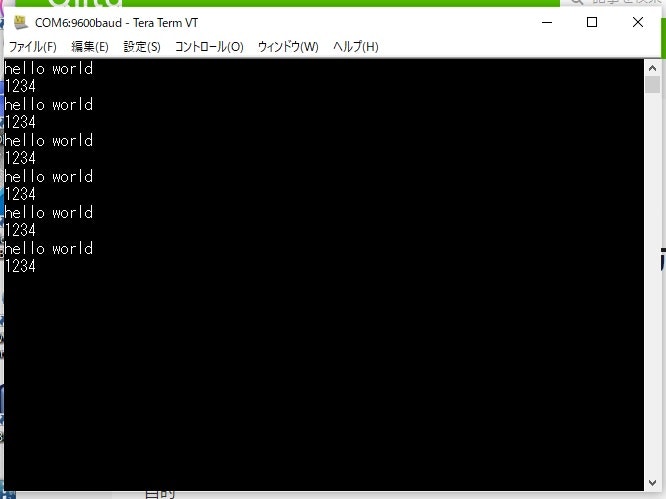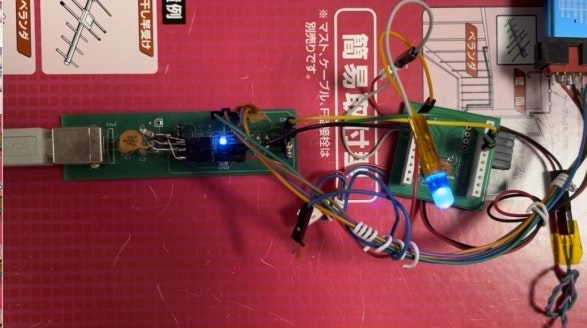x 超超重要 なぜか秋月STM32G031J6M6がうり切れていた。注意!!(2022/8/27現在)
x 過去ログを見よ!!
x Mbedでのボード設定は、NUCLEO-G031K8
x ここで言うSTM32G031は、秋月で売っているSTM32G031J6M6の事
目的
I2Cスレーブのテスト
参考
//i2c_usart_0x80_031_1
#include "mbed.h"
//1 LED
//2 VDD
//3 GND
//4 Serial 9600bps (PA_2)
//
//5 SWCLK
//6 SWDIO
//7 SDA
//8 SCL
//GPIOの初期化
DigitalOut myled(PB_7);//LED1
//シリアルの定義
UnbufferedSerial serial_port(PA_2, PA_3); //031
//I2Cの初期化
// sda scl
I2CSlave slave(PA_12, PA_11); //0031
//メイン関数
int main()
{
//シリアルの初期化
serial_port.baud(9600);
serial_port.format(
/* bits */ 8,
/* parity */ SerialBase::None,
/* stop bit */ 1
);
char buf; //I2Cバッファー
//I2Cスレーブのアドレスの設定
slave.address(0x80);
//無限ループ
while(1) {
//I2Cの状態の読み出し(ポーリング)
while (slave.receive() != I2CSlave::WriteAddressed) {}
myled = 1;//LEDの点灯 debug
//I2Cスレーブの受信バッファーを読み取る
slave.read(&buf, 1);
//I2Cスレーブの受信データの出力
serial_port.write(&buf, 1);
myled = 0;//LEDの消灯 debug
}//while
}//main
main.cpp
//I2C_TEST_STRING_R1_031_1
#include "mbed.h"
#include "OUT80.h"
DigitalOut myled(PB_7);
// sda scl
I2C i2c(PA_12, PA_11); //031
//メインプログラム
int main()
{
OUT80 out80(&i2c);
//無限ループ
while(1) {
myled = 1;//LEDをオン
//I2Cに文字列を出力
out80.ns_puts( (char *)"hello world\r\n");
//I2Cに文字列を出力
out80.ns_printf( (char *)"%d",1234);
//I2Cに文字を出力
out80.ns_putc('\r');
out80.ns_putc('\n');
myled = 0;//LEDをオフ
wait_us(1000*1000);//1秒待つ
}//while
} // main
OUT80.h
//OUT80.h
#include "mbed.h"
struct OUT80 {
OUT80( I2C *i2c );
void initialize();
void ns_putc(char ch);
void ns_puts(char *str1);
void ns_printf(char* fmt, ...);
I2C *_i2c;
};
OUT80.cpp
//OUT80.cpp
#include "mbed.h"
#include "OUT80.h"
//最初に呼ばれるプログラム
OUT80::OUT80( I2C *i2c )
{
_i2c = i2c;
initialize();
}//OUT80
//イニシャライズ
void OUT80::initialize()
{
//_i2c->write(0x80, "START", 3);
}//initialize
void OUT80::ns_putc(char ch)
{
_i2c->write(0x80, &ch, 1);
wait_us(1000);//約1ms秒待つ
}//ns_putc
//文字列の表示 nana_seg
void OUT80::ns_puts(char *str1)
{
//文字の中身がゼロか
while(*str1) {
ns_putc( *str1 ++);
} //while
}//ns_puts
void OUT80::ns_printf(char* fmt, ...)
{
char buff[256];
va_list args;
va_start(args, fmt);
vsnprintf(buff, sizeof(buff), fmt, args);
va_end(args);
char *s = buff;
while (*s) {
ns_putc(*s++);
}//while
}//ns_printf

